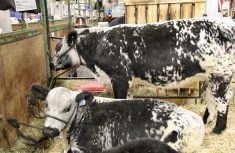Bad habits create a backwash of damage in places where people live. Old garbage dumps litter the Prairies. Every farm site at one time had a corner dedicated for refuse. Coulees were convenient places to rid the garage and home of unwanted things — out-of-site, out-of-mind. Through the generations, many items — some harmful — were dumped and forgotten by Prairie residents and never mentioned when farms changed hands.
Unfortunately, little thought was given to discarded batteries, containers of used oil from the days of lead-based gas additives, lead-based paint and elemental lead. Few appreciate lead’s tenacity as an environmental contaminate. A used car battery buried in a blow-dirt ridge, for instance, is still highly toxic when exposed by erosion 50 years later.
Read Also

The Canadian Cattle Association’s international advocacy efforts
Global ag policies affect Canadian food policy, so the Canadian Cattle Association participates in international and domestic forums
The lead-acid battery was invented in 1859 and though more highly refined today, it remains an automotive standard. Approximately 60 per cent of a battery’s weight is lead and lead oxide. In North America, between 2.6 and three million metric tonnes of lead are used in batteries every year. Today a high percentage of lead is recycled, but for many years thousands of tonnes of this heavy metal were carelessly discarded in private dump sites. Over time, dump sites were unwittingly incorporated into cultivated fields and pastures. Because lead degenerates very slowly, these dumps become a long-term source of lead poisoning for cattle, sheep and horses. Many people forget to ask about old dump sites when looking for opportunities to graze crops hurt by drought, hail or post-harvest leftovers. Something that needs to be remembered: Lead exposure in food animals is a potential food safety issue, especially in children. Blood lead levels below the existing U.S. Centers for Disease Control and Prevention’s established “safe” thresholds for public health action were associated with adverse educational outcomes in children. There is no safe level of lead in humans.
Canada, the U.S., Great Britain and Australia all report lead exposure as the most common cause of cattle poisoning. Lead poisoning can affect any cattle operation and often involves animals from well-managed farms and ranches. Sometimes only a single calf may be involved, but at other times 20 or more animals may be lost in a single poisoning incident. Cattle readily drink crankcase oil, lick grease from machinery, lick paint and chew on exposed plates of a deteriorating lead battery. One animal showing clinical signs usually signals exposure and potential poisoning in other animals. Ingested lead settles in the forestomachs of cattle where digestive acids gradually change lead into poisonous salts, which are absorbed and widely distributed in an animal’s body. Lead poisoning is common among calves because of their inquisitive feeding habits and the fact that lead is more readily absorbed from the gastrointestinal tract of younger animals.
More than 85 per cent of lead poisoning incidents among cattle in Alberta result from accidental consumption of discarded materials from farm vehicles or machinery. Garbage dumps remain the most common source of poisonous materials. Over the years, other sources have included crop sprays, putty, lead-based paints and painted surfaces, roofing materials, plumbing supplies, asphalt, lead shot, linoleum and oil field waste. Boiled linseed oil, which contains lead, may poison livestock when used as a laxative.
Although clinical signs of poisoning normally precede death, most animals are simply found down or dead on pasture. Clinical signs usually develop very quickly after exposure, but may take a week or more. The first signs are often depression, loss of appetite, perhaps diarrhea. Nervous signs if observed before death include teeth grinding, twitching of eyes and ears, head bobbing, circling, head pressing, staggering, muscle tremors and blindness. Death usually results from respiratory failure during convulsions or can be associated with misadventure such as drowning when blind animals wander into ponds and dugouts. Animals often die within 12 to 24 hours after clinical signs are first noticed. Elevated lead levels in blood, kidney and liver are used to confirm a diagnosis. In many cases, lead is visible in the gastrointestinal tract on post mortem.
A correct diagnosis is extremely important for identifying the problem and preventing further exposure. All too often livestock owners are unaware of the presence of the source of lead. A walkabout after a confirmatory diagnosis of lead poisoning invariably turns the “just can’t be” into a “didn’t know the dump was there.” Some within the food, veterinary and livestock industries would prefer to never have animals exposed to lead entering the food chain. The best solution is preventing these problems, which are totally created by people.

















